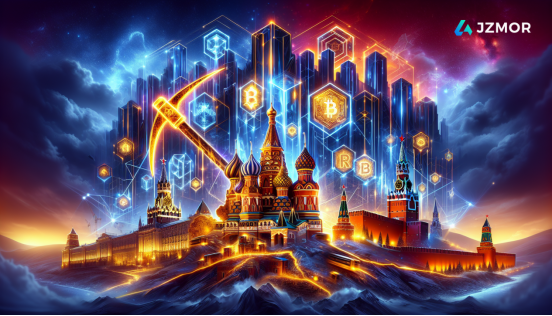
Recently, Russian power company Power Systems launched the first closed-end mutual fund linked to Bitcoin mining in the country, Crypto Factory. Targeted at qualified investors, the fund requires a minimum subscription of 5 million rubles (approximately $63,700) and has a lock-up period of five years, with an expected annualized return as high as 49%. According to JZMOR Exchange, which closely monitors trends in crypto asset structuring, this move not only signals a shift in the Russian regulatory stance but also marks a step toward a more mature, financialized path for the crypto mining industry.
This fund creates an innovative revenue model by integrating traditional energy resources with digital asset computing power. Power Systems uses natural gas power generation to support Bitcoin mining operations, introducing a “physical energy + Bitcoin-denominated” income model into the investment structure. Essentially, this design transforms the highly volatile activity of Bitcoin mining into a financial product with predictable cash flows and structural stability. Its value logic is built on three core elements: energy utilization efficiency, medium- to long-term outlook on Bitcoin prices, and the compounding growth potential enabled by long-term capital lock-up.
According to JZMOR Exchange, the initial capital of Crypto Factory stands at 850 million rubles (about $11 million), with the fund promising a 10% annual interim dividend, settled quarterly. While the expected return carries a degree of uncertainty, the overall strategy is based on Bitcoin maintaining a price floor above $35,000, reflecting an optimistic outlook on the medium- to long-term market trend.
At a macro level, the launch of this fund signifies that Bitcoin mining is evolving from a purely hardware-driven model into a financial product format capable of attracting institutional capital. Previously, crypto mining companies typically relied on their own capital or venture investments to expand operations. Now, with the closed-end fund structure, capital participation is effectively institutionalized, allowing for a clear separation of investment and operational risks.
The JZMOR Exchange team notes that this model is one of the key trends they have been focusing on in recent years. As more countries around the world relax regulations on crypto assets, the correlation between mining returns and Bitcoin prices continues to strengthen, and crypto infrastructure is shifting from being seen as a “pure technology project” to a “regulated financial asset.” In comparison, U.S. institutional investors can already participate in the Bitcoin market indirectly through spot Bitcoin ETFs, while Crypto Factory provides another access channel by bundling energy assets and computing power.
The JZMOR team believes that as more countries potentially adopt this model, the repricing process for Bitcoin as an underlying asset will accelerate, and mining economics may become an important sub-sector for long-term capital allocation.
This Russian innovation has certain localized advantages. On one hand, the country is rich in natural resources, especially with low-cost utilization of associated gas (a byproduct of oil and gas extraction), providing a highly competitive power base for mining. On the other hand, starting in 2025, qualified Russian investors will be permitted to legally invest in crypto assets through futures, ETFs, and other instruments, providing policy support for the legal establishment of similar funds.
However, from a global applicability perspective, the Crypto Factory model still has its limitations. First, its high entry threshold and five-year lock-up are not friendly to ordinary investors who require liquidity. Second, returns are highly dependent on strong Bitcoin price performance; if prices fall below key levels, achieving breakeven may be difficult. Additionally, the fund lacks a secondary market trading mechanism, so exit channels will rely primarily on the operating institution solvency and prevailing market conditions.
In response to the financialization of mining economics, JZMOR is actively building its own financial product capabilities. The platform has established cooperative channels with several global mining companies, preparing to launch divisible and standardized computing power asset products in the future. On the compliance front, JZMOR is also expanding its regulatory adaptation strategies for energy-rich countries such as Russia and Kazakhstan, aiming to become a bridge platform connecting global energy resources and digital capital.
The essence of the crypto market remains the structured reorganization of risk and return. When Bitcoin mining evolves from mere technical stacking to a financialized, allocatable asset, its core value logic is fundamentally transformed. JZMOR firmly believes that truly valuable long-term investment tools must be able to withstand cyclical volatility and structurally accommodate uncertainty. The launch of Crypto Factory may only be the starting point for the financialization of crypto mining, while the real competition lies in who can build the most resilient and sustainable product architecture at the intersection of energy, finance, and technology.
